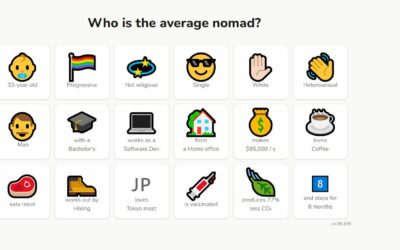|
|
A swathe of recent articles have compared the experience of being a digital nomad to being homeless. One LinkedIn writer suggested that:
Being a digital nomad is a lot like being a hobo. You have no home, drink too much, and often get stared at. When you speak, nobody understands, and you usually wander the streets confused. I guess one difference is you don’t beg for change, just wi-fi.
The author is clearly not serious in his comparison of choosing to live the privileged life of a digital nomad with the serious challenge of homelessness. But it is a dramatic way to bring attention to the question of what it means when you don’t really have a place to call home.
The idea of the digital nomad lifestyle is to embrace freedom. You embrace autonomy in choosing where and how you live your life. You aren’t tied to a specific place, culture, cost of living, or the 9-5 grind. But in exchange for this freedom, you make sacrifices, chief among them the security and community that comes with having a place to call home.
Giving an interview with iNews, another digital nomad described some of the challenges that come with not having a home. She described the challenge of packing up all your possessions and carrying them with you everywhere you go. She described how the loss of routine impacted her mental health, and how relying on new and often short friendships for connection turned out to be emotionally draining.
These are challenges that some homeless people might also identify with. But digital nomads have the benefit that they aren’t “stuck”. If you are struggling with being constantly on the road, you can make changes.
But is Homelessness the Only Choice?
Dozens of studies that have surveyed and interviewed digital nomads have highlighted that loneliness, isolation, and loss of security are the biggest challenges that digital nomads face. These are all intimately linked with homelessness and sacrificing the security of a permanent home that you have created for yourself and the stable community that comes with home.
But these studies also assume that to become a digital nomad you must give up your home, sell most of your possessions, and take on the world with just a laptop and a backpack. You must turn your back on “home” for months or even years on end, maintaining long-distance relationships while traveling around as much of the world as possible at a breakneck speed.
But while this is a traditional description of a digital nomad, as more people are able to live and work location independently, it is becoming dated.
Shuttling
A few months ago, we shared an article by Austin Zeng, a digital nomad who calls himself a shuttler and splits his time more or less 50/50 between Japan and Singapore. Rather than having no home, he has two. While he still gets FOMO when he misses out on things when he is away, he is building multiple communities rather than choosing a life distanced from his community.
Home Base
While Zeng may have coined the name shuttler for himself, it is not a new concept. Many digital nomads choose to have a home base. They might spend six months “at home”, while still enjoying the flexibility of full remote working, and then traveling for the other six months of the year (or any other division).
Many digital nomads believe that this gives them the best of both worlds, as they can enjoy the stability of home while still pursuing adventure. The drawback is that it tends to be a more costly way to live because you must maintain your home base while traveling and paying for accommodation on the move.
This is often a preferred mode of travel for young digital nomads who are happy to live with their parents while at home, and older digital nomads, or grey nomads, who have already paid off their homes.
Slowmadism
Other digital nomads face the problem of connection and home with slowmadism, which simply means spending more time in each location before moving on. This allows nomads to create relatively stable homes and form deeper and more genuine friendships as they spend more time in the community.
While slowmadism used to mean spending three to six months in a place, largely due to visa restrictions, the rise of digital nomad visas means that many now choose to spend one or two years in a place before deciding what to do next.
Many of these digital nomads fall in love with their new homes and become digital expats.
Choosing How to Live
You will definitely meet “purists” out there who insist that to be a digital nomad you must be constantly on the move and not tethered to a place called home. But we believe it is time to come to terms with the fact that being a digital nomad isn’t really about travel at all. It is a life philosophy that is about working to live rather than living to work.
Most people build their lives around their work. Where you live and how you organize your time is dictated by where you work. What time you have to wake up in the morning, how you organize childcare, and even what you wear is largely dictated by work.
Digital nomads take the opposite approach. They put creating the life they want first, and then find work that allows them to live that life, which usually means remote flexible working. For most, this involves travel since the world is an exciting and enticing place. If you could travel whenever you wanted, why wouldn’t you?
But if a digital nomad chooses to stop traveling for two years, perhaps to look after a family member who is important to them, does that mean that they are no longer a digital nomad? Do digital nomads who get visas that allow them to live and work in a country for one to two years suddenly become expats, even if they intend to move on when their visa is up?
In our opinion, if they are still where they want to be and building the lives they want through remote working, they are still a digital nomad.












